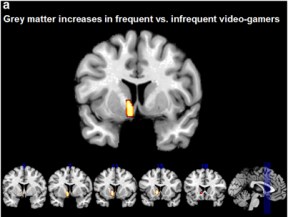A study by an international research team has shown a correlation between frequent gaming and a greater volume of grey matter in a part of the brain linked to an internal reward system associated with addiction. Take a few minutes to parse that sentence, I’ll wait. The study, published today in Nature’s Translational Psychiatry journal, describes the analysis of fMRI scans of 154 14-year-old gamers. They found that the ventral striatum, part of the dopamine system and implicated previously in addiction studies, was larger in gamers who played more frequently, though the data was strictly correlative and should not be taken as evidence of causality.
It’s worth considering for a moment because studies like this always end up hitting network news after a day or two, with ridiculous simplifications and ominous speculations. Are Violent Video Games Literally Warping Our Children’s Brains? Find out — after this message!
In fact, a quick search shows that the Reuters report (which, I should say, is not actually inflammatory) has already propagated to a number of networks and AP outlets. None of them link to the actual paper, though, which can be found here.
The study is really quite straightforward, comparing the structural and behavioral differences between two groups: frequent and infrequent gamers. The results show that frequent gamers have a larger volume of cortex in their left ventral striatal cortex, that they showed less deliberation in making choices in the gambling game they played, and that there was more brain activity corresponding to wins and losses.
The natural way to spin the story is to say that playing games has affected the brain, though there is no evidence this is the case. In fact, the reverse is more logical: people predisposed to addiction are more likely to participate in potentially addictive activities. This puts video game addiction in the same category as other, more widely-recognized addictions. Comorbidity with social and anxiety disorders
Studies like this are a great way to attack technology and services. Twitter use, for example, almost certainly correlates to people with shorter attention spans. Causality? Undetermined, but it’s convenient to argue that Twitter use enables that short attention span. The implication is that these people should be doing things that combat that short attention span, but this ignores so many other variables (total engagement, social trends, improvement in multitasking ability, etc) that it’s easily recognizable as wishful thinking.
With games the market is getting large and mainstream enough that the doomsaying of early days has been conclusively proven wrong, but the topic, despite being a multi-billion dollar market comprising some of the most interesting and powerful companies in the world, remains incendiary. Be on the lookout for FUD, and value research like this for what they are: small steps towards understanding the relationship between behavior and physiology, not to be used as planks in anyone’s anti- or pro-gaming platform.
